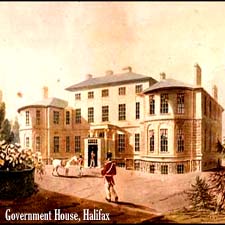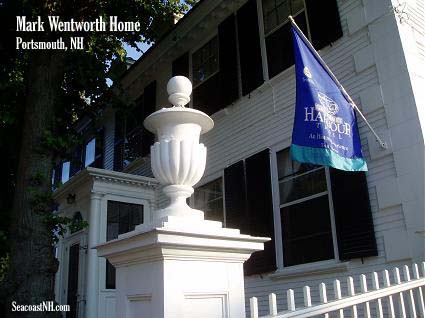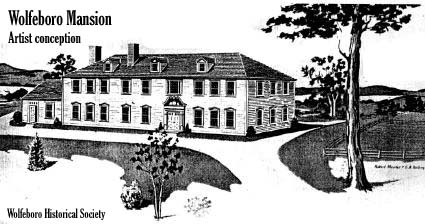|
FRESH STUFF DAILY |
|
|
||
|
|
||
|
|
||
|
SEE ALL SIGNED BOOKS by J. Dennis Robinson click here |
||
Page 1 of 2
He had the common touch, at least as a young man. But from Portsmouth to Wolfeboro to Halifax, New Hampshire’s last royal governor had ritzy tastes in real estate. Here, for the first time that we know of, is a look at all three governor’s mansions and the racy Portsmouth couple that lived there.
SEE ALSO: Gov. John Wentworth bio and Lady France Wentworth poem Unlike his imperious uncle Benning, New Hampshire’s last royal governor John Wentworth was a heck of a nice guy. Born in Portsmouth in 1737 to the aristocratic Wentworth dynasty, John attended Harvard in the same class as future president John Adams. Where Gov. Benning Wentworth had grown increasingly fat and rich and aloof and haughty, Gov. John Wentworth created new highways through the wilderness, helped found Dartmouth College, built the colonial statehouse in Market Square and mixed with the locals.
Despite his common touch, John Wentworth inherited the family yen for ritzy real estate. His father Mark Wentworth’s home, now the Wentworth-Gardner mansion in the South End is still considered among New England’s finest examples of Georgian architecture. Uncle Benning’s rambling home overlooking Little Harbor, now the Wentworth-Coolidge Mansion, once boasted 45 rooms. After accepting his powerful role as provincial governor in 1767, John described his new rented home on Pleasant Street as "a small hut with little comfortable apartments". The governor was more generous in his description of the surrounding scenery. He wrote to a friend: "On the one side, we look over the town and down the river to the boundless Atlantic Ocean; on the other side we overlook a place for a garden, bounded or rather separated from the fields by a large sea-water pond, which enlivens the rural scene." The scenic view of the South Mill Pond (then called Pickering Pond) remains, but the "small hut" has expanded enormously toward the river with a modern brick addition. It is now the Mark Wentworth Home, a nursing facility for the elderly. It is named, confusingly, not for John Wentworth’s father Mark, but for a doctor who lived there at the turn of the 20th century. Built in 1762, the "front house" still vibrates with scandalous Portsmouth tales. It was here that John Wentworth brought his bride Frances in 1769 after their sudden wedding. Frances married her first cousin John just 10 days after the funeral of her first husband Theodore Atkinson, Jr, another first cousin. Based on the private baptism date of their son a few months later, it appears that the governor and his lady had dallied while poor Mr. Atkinson lay dying. It was here on the eve of the American Revolution in 1775 that a Portsmouth mob armed with a cannon carried away a Tory friend who had been hiding with the governor. Wentworth Home administrator Mary Ellen Dunham points out the "famous bullet holes" above the mantelpiece in her office, reputedly made in the plaster during the scuffle. From Pleasant Street the Wentworths fled as the American Revolution loomed. They stayed for two months in a truly tiny house at Fort William and Mary in New Castle and on the British ship SCARBOROUGH, then moved on to Boston, to England and eventually to Nova Scotia where John again became royal governor.
This was the "elegant seat" where Governor Wentworth apparently intended to move the state capital, connecting the center of the state to the sea with planned highways and canals. The interior, with its wide-paneled wainscoting, wide stairway, brocade curtains, Piscataqua furniture, pewter chandeliers and brass fixtures was equally grand. This is an educated guess. The mansion later burned to the ground and today is marked only by a stone-lined cellar hole and a brass plaque. No one is certain exactly how the mansion appeared or was appointed. It was still a work in progress, the two great chimneys still unfinished, by 1775 when the Wentworths fled. The Tory governor’s property was seized by the patriot state of New Hampshire and sold at auction. An advertisement for the mansion, considered before the Revolution to be among the finest private homes in the colonies, appeared in the New Hampshire Gazette. The sale in 1786 included, according to the newspaper notice, "all the Improvements and Additions of Stock, Furniture, Tools, Etc.". CONTINUE Wentworth Mansions article
Please visit these SeacoastNH.com ad partners.
News about Portsmouth from Fosters.com |
| Thursday, April 25, 2024 |


|
Copyright ® 1996-2020 SeacoastNH.com. All rights reserved. Privacy Statement
Site maintained by ad-cetera graphics

 HISTORY
HISTORY





















